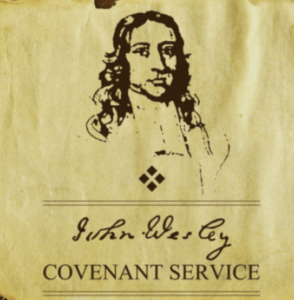Whatever future 2022 may hold, one thing is certain: Come the first Sunday in January, millions of United Methodists will renew their vows in a beloved tradition known as the Wesley Covenant Service. This year, however, the covenant service takes place amid tensions over the impending split of The United Methodist Church that shades its spiritual commitment with uncertainty.
First, the tradition. From small to medium-sized churches such as Main St. UMC in Kernersville, N.C., Peterborough UMC in Peterborough, N.H., and The Fount in Fountain Valley, Calif., to megachurches such as United Methodist Church of the Resurrection in Leawood, Kan., the Wesley Covenant Service is a fixture of New Year’s celebrations throughout the denomination. Church of the Resurrection is so fond of the covenant service’s centerpiece, the Wesley Covenant Prayer, that it produces the prayer in both traditional and contemporary versions in pocket cards and bookmarks sold through its store, The Well.
Methodism’s founder, John Wesley, was famous for “plundering the Egyptians“ (Exodus 3:21-22), that is, adapting anything he found valuable from religious or secular culture into tools for spiritual discipline. He introduced the covenant service in 1755 and it quickly became a fixture of the Methodist movement. Discipleship Ministries, the UMC’s agency for local-church resources, quotes The United Methodist Book of Worship’s description of the service’s origin:
In 1663 Richard Alleine, a Puritan, published Vindiciae Pietatis, or, “A Vindication of Godliness in the Greater Strictness and Spirituality of It.” In 1753, it was again published in John Wesley’s A Christian Library. Wesley used one chapter, “The Application of the Whole,” on Monday, August 11, 1755, in what probably was the first real celebration of the Covenant Service in the Methodist movement. Wesley found the service rich and meaningful, as expressed in his Journal: ‘Many mourned before God, and many were comforted’ (April 1756); ‘It was, as usual, a time of remarkable blessing’ (October 1765).”
The instructions, or rubrics, for the covenant service urge church leaders to recognize the seriousness of the liturgy and the prayer. Again, from the Book of Worship:
The heart of the service, focused in the Covenant Prayer, requires persons to commit themselves to God. This covenant is serious and assumes adequate preparation for and continual response to the covenant. Leaders of worship must take seriously the need to prepare the congregation for this service, possibly through study sessions and prayer. The leaders must also assume responsibility to assist persons to be faithful to the covenant, possibly through meetings for spiritual discipline.”
 Clearly, the covenant service isn’t the kind of Sunday worship in which merely mouthing familiar words will suffice. Author Chris Folmsbee created a three-week study called “The Wesley Prayer Challenge” to take participants even deeper into the way of “remembering, renewing and surrendering themselves in complete trust to God,” according to the book’s description. In the mid-to-late 1990s, a modern version of the prayer was developed to update Wesley’s 18th century language, although many longtime United Methodists prefer the original:
Clearly, the covenant service isn’t the kind of Sunday worship in which merely mouthing familiar words will suffice. Author Chris Folmsbee created a three-week study called “The Wesley Prayer Challenge” to take participants even deeper into the way of “remembering, renewing and surrendering themselves in complete trust to God,” according to the book’s description. In the mid-to-late 1990s, a modern version of the prayer was developed to update Wesley’s 18th century language, although many longtime United Methodists prefer the original:
I am no longer my own, but yours.
Put me to what you will, rank me with whom you will;
put me to doing, put me to suffering;
let me be employed for you, or laid aside for you,
exalted for you, or brought low for you;
let me be full,
let me be empty,
let me have all things,
let me have nothing:
I freely and wholeheartedly yield all things
to your pleasure and disposal.
And now, glorious and blessed God,
Father, Son and Holy Spirit,
you are mine and I am yours. So be it.
And the covenant now made on earth, let it be ratified in heaven.
Amen.
(As used in the British Methodist Worship Book, 1999)
Now, the challenge. This year, the Covenant Renewal Service will take place against a backdrop of tension and turmoil. While coronavirus and its many variants rage around the planet, which is itself under stress from the climate emergency, United Methodists will be — or at least ought to be — searching their hearts over whether the 12-million-member worldwide denomination will fracture into two or more pieces.
Two developments during the week between Christmas Day and New Year’s Day illustrate the conflict.
This year, the Covenant Renewal Service will take place against a backdrop of tension and turmoil.
First, the Wesleyan Covenant Association, an organization of traditionalists focused on starting a new, stricter Methodist church, unveiled what it calls “The Way to the Kingdom,” a prayer guide developed by its International Intercessory Prayer Network. (The latter echoes a longtime United Methodist resource, The Upper Room Living Prayer Center, which offers support via telephone and internet).
Distributed by email on Dec. 29, the WCA’s January prayer guide lists specific intercessions for which participants are asked to pray. Among them is a request that many United Methodists may find controversial:
“Friday: Pray through any impediment to the spirit of the Protocol, and toward a creative and life-giving solution that honors Christ and gives a winsome witness to the world of what can be (Matt. 5:11-16).
The Protocol, known formally as “The Protocol for Reconciliation and Grace Through Separation,” offers a proposed split of the UMC in a document negotiated outside official channels. The Protocol must be adopted by the UMC’s worldwide legislative assembly, the General Conference, to be effective.
During the two years that the coronavirus pandemic has postponed General Conference, now slated for Aug. 29-Sept. 7, 2022, momentum for the Protocol has slackened. Waning interest in the Protocol alarms WCA adherents because the proposal includes $25 million in start-up money for a new traditionalist denomination such as the WCA’s version, the Global Methodist Church.
Second, in the third part of his series on the state of the UMC, blogger Jeremy Smith of Hacking Christianity asserts the goals of the two main United Methodist factions:
- “Traditionalists are trying to avoid the fate of other mainline schismatic movements before them by starting out with money and property that would allow them to shape culture through people power and political influence like fundamentalist influences outside of the Wesleyan tradition. The GMC and the Protocol are their last, best hope.
- “Progressives are trying to avoid the fate of other sister mainline denominations that turned into smaller, like-minded traditions — that continue to affect change and grow disciples, to be sure, but no longer shape culture through people power and political influence. A more inclusive and just United Methodism continues to be that preferred future for most.”
A longtime observer of traditionalist United Methodist politics, Smith contends that the WCA’s true goal isn’t two viable denominations, the UMC and the GMC, but the destruction of the so-called “liberal” United Methodist Church.
Smith contends that the WCA’s true goal isn’t two viable denominations, the UMC and the GMC, but the destruction of the so-called “liberal” United Methodist Church.
He writes: “In every corner of traditionalists online, it is anathema to the Traditionalists to give The UMC anything to stand on. The house must be gutted before it is sold in the divorce. The libs must be owned.” (Smith’s emphasis).
Smith posits that the best outcome for The United Methodist Church is some form of compromise, such as the Alaska Omnibus. Trouble is, after half a century of fighting over the presenting issues of the schism, most notably LGBTQ acceptance, no one is sure whether any of the UMC’s movers and shakers have the heart to loosen their death-grips on their own future visions.
Such an impasse lies distinctly at odds with the spirit and words of Wesley’s Covenant Prayer. If United Methodists are to surrender truly to God’s will for the denomination in 2022, the Covenant Service will have to work a miracle in their polarized hearts and minds.
Among those who long for discernment of the future, the watchword for the new year may well be Matthew 19.26: “But Jesus looked at them and said, ‘For mortals it is impossible, but for God all things are possible.’”
Cynthia B. Astle is a veteran journalist who has covered the worldwide United Methodist Church at all levels for more than 30 years. She serves as editor of United Methodist Insight, an online journal she founded in 2011.
Related articles:
Analysts hope to help congregations understand the options with potential United Methodist split
Now there appear to be three paths for once-united Methodists
Top-down schism plans ignore local United Methodist churches’ new reality


